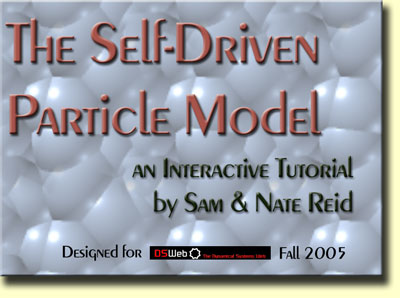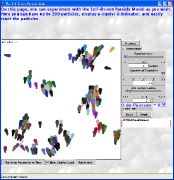
Launch the Interactive Tutorial via Java Web Start
The
Self-Driven Particle Model,
an Interactive Tutorial by Sam and Nate Reid.
Designed for SIAM's DSWeb Tutorials, Fall 2005
an Interactive Tutorial by Sam and Nate Reid.
Designed for SIAM's DSWeb Tutorials, Fall 2005
Abstract
The Self-Driven Particle Model is a toy dynamical system in which particles move in 2-dimensions, and interact with each other according to a simple rule. Particles move at a constant speed, and their orientation is set to be the average orientation of all particles (including themselves) within an interaction radius, plus a random term. This model has been shown to exhibit complex dynamical behavior, including a 2nd order phase transition, criticality and clustering. This tutorial introduces the model incrementally, and depicts the computation of the order parameter, critical parameter and critical exponent.
Introduction
The Self-Driven Particle Model was proposed as a minimal description of swarming behavior in 2-dimensions, and has been compared to transport of groups of quadrupeds, bacterial migration and bird flocking. The system was first studied by [1], a special case of the model introduced by [2]. Although more realistic models have been developed for direct study of such systems [3], the Self-Driven Particle Model remains important because of the model simplicity richness of the emergent phenomena. The model is analagous to the Ising model, with particle randomness analagous to temperature, and particle clusters analogous to spin clusters [1].
This system is highly visual, and the emergent properties are easy to visualize. We hope that this introductory tutorial will facilitate visualization and understanding of emergent complex phenomena.
The Tutorial
The Tutorial is organized into three main sections:
I. Introduction to the Model
II. Emergent Properties
A. Order Parameter
B. Criticial Values
C. Critical Exponent.
III. Open-Ended platform for experimentation.
This Interactive Tutorial requires
Java 1.4.2 and up:

Once you have verified your Java 1.4.2+ installation:
Launch the Interactive Tutorial via Java Web Start now!
Screenshots available

Click here to View Screenshots

Once you have verified your Java 1.4.2+ installation:
Launch the Interactive Tutorial via Java Web Start now!
Screenshots available

Click here to View Screenshots
Errata (Known Bugs)
References
[1] T. Vicsek, A. Cziro´k, E. Ben-Jacob, I. Cohen, and O. Shochet, Novel type of Phase Transition in a System of Self-Driven Particles, Phys. Rev. Lett. 75, 1226 (1995).
[2] C. Reynolds. Flocks, birds, and schools: a distributed behavioral model. Computer Graphics, 21:25–34, 1987.
[3] D. Helbing, Traffic and Related Self-Driven Many Particle Systems, Reviews of Modern Physics, 2001
[4] C. Huepe, M. Aldana, Intermittency and Clustering in a System of Self-Driven Particles, Physical Review Letters, Vol. 92, #16, 2004.
[5] A. Jadbabaie, J. Lin, and A. S. Morse, Coordination of Groups of Mobile Autonomous Agents Using Nearest Neighbor Rules, IEEE Transactions on Automatic Control, Volume 48, Issue 6, June 2003, pages 988-1001.
References
[1] T. Vicsek, A. Cziro´k, E. Ben-Jacob, I. Cohen, and O. Shochet, Novel type of Phase Transition in a System of Self-Driven Particles, Phys. Rev. Lett. 75, 1226 (1995).
[2] C. Reynolds. Flocks, birds, and schools: a distributed behavioral model. Computer Graphics, 21:25–34, 1987.
[3] D. Helbing, Traffic and Related Self-Driven Many Particle Systems, Reviews of Modern Physics, 2001
[4] C. Huepe, M. Aldana, Intermittency and Clustering in a System of Self-Driven Particles, Physical Review Letters, Vol. 92, #16, 2004.
[5] A. Jadbabaie, J. Lin, and A. S. Morse, Coordination of Groups of Mobile Autonomous Agents Using Nearest Neighbor Rules, IEEE Transactions on Automatic Control, Volume 48, Issue 6, June 2003, pages 988-1001.